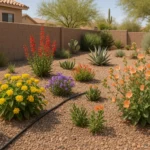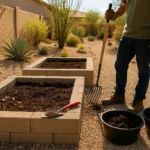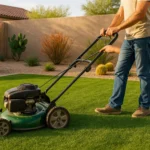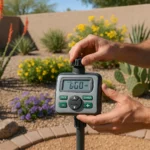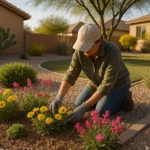Spring in the Southeast Valley brings the perfect opportunity to transform your yard into a vibrant oasis of color. While our desert climate presents unique challenges, with the right approach, you can grow spectacular flowers that thrive in our conditions. From preparing nutrient-rich soil with compost to selecting the perfect desert-adapted blooms, this guide will walk you through creating a stunning, sustainable flower garden that stands up to our intense sun and conserves precious water.
Understanding Our Southeast Valley Growing Environment
The Southeast Valley’s growing conditions are distinct from much of the country. Our alkaline soil, low rainfall (averaging just 8-9 inches annually), and temperature swings require thoughtful planning. Spring offers a narrow but ideal planting window when temperatures hover between 70-90°F before summer’s intense heat arrives. This period from late February through April is prime time for establishing flowers that will provide months of color.
Our region’s USDA hardiness zones range from 9a to 10a, meaning we rarely experience freezing temperatures. This allows for growing many varieties that wouldn’t survive colder climates, but it also means we need plants that can withstand prolonged heat and drought. The good news is that many beautiful flowering plants have adapted to these exact conditions, evolving efficient water-storage capabilities and deep root systems that help them thrive in our desert environment.
Southeast Valley gardeners also contend with soil that’s typically high in calcium and low in organic matter. This is where thoughtful soil preparation becomes essential—and why compost is your best friend for desert flower gardening success. With proper amendments and plant selection, you can create a garden that’s both water-wise and bursting with color.
Building Desert Soil: The Compost Starter Advantage

The foundation of any successful flower garden in the Southeast Valley begins with soil improvement. Our native soil tends to be heavy clay or caliche with poor drainage and minimal organic matter. Compost is the miracle cure for these issues. Creating or purchasing quality compost introduces beneficial microorganisms, improves soil structure, and enhances water retention while still allowing proper drainage—critical factors for desert gardening success.
To create a compost starter that accelerates decomposition, mix equal parts green materials (fresh grass clippings, vegetable scraps, coffee grounds) with brown materials (dried leaves, shredded paper, small twigs). Add a shovelful of existing garden soil or purchased compost accelerator, which contains microorganisms that jumpstart the decomposition process. Maintain moisture similar to a wrung-out sponge and turn your pile every few weeks. In our warm climate, you’ll have usable compost in just 2-3 months—significantly faster than cooler regions.
When preparing flower beds, incorporate 3-4 inches of finished compost into the top 8-10 inches of soil. This single step dramatically improves water retention while preventing the compaction common in our native soils. For established beds, add a 1-2 inch layer of compost annually as a top dressing. The difference in plant performance is remarkable—flowers grown in compost-enriched soil typically require 30-40% less water and produce more abundant blooms than those planted in unamended desert soil.
Water-Wise Techniques for Desert Flower Gardens
Efficient watering techniques are essential for growing flowers successfully in the Southeast Valley. Drip irrigation stands as the gold standard, delivering water directly to plant roots with minimal evaporation. For flower beds, use emitters that provide 0.5-1 gallon per hour, spaced to create overlapping wet zones. This encourages roots to spread laterally, increasing drought resilience. Set your system to water deeply but infrequently—typically 2-3 times weekly in spring, adjusting as temperatures rise.
Mulching is equally important for water conservation. Apply a 2-3 inch layer of organic mulch like shredded bark, compost, or straw around your flowers, keeping it pulled back slightly from stems. This protective layer can reduce evaporation by up to 70% while moderating soil temperature fluctuations that stress plants. In the Southeast Valley’s intense sun, mulch breaks down quickly, so plan to replenish it seasonally.
Consider hydrozoning—grouping plants with similar water needs together. Create dedicated beds for moderate-water flowers separate from extremely drought-tolerant varieties. This prevents overwatering some plants while underwatering others. For example, native penstemons and desert marigolds can thrive with minimal supplemental water once established, while cosmos and zinnias perform best with more consistent moisture. This thoughtful arrangement allows you to tailor irrigation precisely to each plant group’s needs, maximizing both water efficiency and flowering performance.
Spring Color Palette: Low-Water Annuals for Immediate Impact
For instant color that thrives in our Southeast Valley spring conditions, several annual flowers deliver spectacular results while respecting our water limitations. Desert marigold (Baileya multiradiata) tops the list with its bright yellow daisy-like blooms that seem to glow against our desert landscape. These native wildflowers need almost no supplemental water once established and will often self-seed for years of recurring color. Plant them in full sun in well-draining soil for best results.
Globe mallow (Sphaeralcea ambigua) offers coral-orange flowers on silvery foliage, creating a stunning visual contrast. This extremely drought-tolerant plant attracts pollinators and blooms prolifically from early spring through early summer. For a cooler color palette, try desert bluebells (Phacelia campanularia), which produce intense blue-purple flowers that create a striking display when mass-planted. These annuals germinate quickly after our winter rains and thrive in our spring temperatures.
Mexican sunflower (Tithonia rotundifolia) brings fiery orange-red blooms on tall stems, making it perfect for the back of flower beds. These heat-loving annuals actually perform better as temperatures rise, bridging the gap between spring and summer gardens. For smaller spaces or container gardens, angelita daisy (Tetraneuris acaulis) provides months of cheerful yellow flowers on compact plants, requiring minimal water and maintenance. All these annuals can be direct-sown in late winter for spring flowering, making them both economical and easy for beginning gardeners.
Perennial Power: Desert-Adapted Flowers for Long-Term Beauty
Investing in perennial flowers brings multiple benefits to Southeast Valley gardens—they typically develop deeper root systems for better drought tolerance, require less maintenance once established, and return year after year with increasing vigor. Autumn sage (Salvia greggii) ranks among the most reliable performers, offering tubular flowers in shades from red to pink to white that attract hummingbirds and butterflies. These woody perennials bloom heaviest in spring and fall, with sporadic flowering even through summer with minimal water.
Blackfoot daisy (Melampodium leucanthum) creates low-growing mounds covered with small white flowers with yellow centers. These native perennials bloom nearly year-round in the Southeast Valley and thrive in poor soil conditions that would challenge most other plants. For dramatic vertical interest, consider desert spoon (Dasylirion wheeleri), which sends up spectacular 10-15 foot flowering stalks in spring, creating architectural interest even when not in bloom.
Baja fairy duster (Calliandra californica) brings feathery red flowers that resemble miniature fireworks displays. This shrubby perennial blooms heaviest in spring but continues flowering sporadically year-round with proper care. For ground cover applications, trailing lantana (Lantana montevidensis) spreads to form colorful mats of purple, white, or pink flowers that attract butterflies while requiring minimal water once established. When selecting perennials, look for varieties native to the Sonoran Desert or similar regions like South Africa or Mediterranean climates, as these will be pre-adapted to our growing conditions.
Creating Dramatic Container Displays for Patios and Entryways
Container gardening offers Southeast Valley residents flexibility to create stunning flower displays even in small spaces. For desert-friendly containers, material selection matters significantly—unglazed terra cotta, while beautiful, loses moisture rapidly in our climate. Instead, opt for glazed ceramic, concrete, or composite containers that retain moisture longer. Ensure containers have adequate drainage holes, and consider double-potting (placing a planted container inside a slightly larger decorative pot) to reduce heat transfer to the root zone.
When planting containers, use a high-quality potting mix enhanced with 25-30% compost and a small amount of water-retaining polymer crystals. These absorb water during irrigation and release it slowly to plant roots, extending the time between waterings. For dramatic spring displays, consider combinations like silver-leaved dusty miller with bright orange California poppies and trailing purple verbena. This creates the classic “thriller, filler, spiller” arrangement that provides visual interest from all angles.
Strategic placement of containers can maximize impact while minimizing water needs. Group containers together to create higher humidity around plants and reduce water loss. Position them where they’ll receive morning sun but afternoon shade, particularly on west-facing patios that receive intense afternoon heat. Install drip irrigation with individual emitters for each container to ensure consistent moisture without waste. With thoughtful plant selection and proper care, container gardens can provide months of vibrant color while using surprisingly little water.
Supporting Pollinators with Native Flowering Plants
The Southeast Valley’s ecosystem depends on pollinators like native bees, butterflies, and hummingbirds—and these beneficial creatures face increasing habitat loss. Your flower garden can serve as a crucial oasis by incorporating native flowering plants specifically evolved to support local wildlife. Chuparosa (Justicia californica) produces tubular red-orange flowers perfectly shaped for hummingbird beaks, while desert senna (Senna covesii) provides both nectar for adult butterflies and serves as a larval host plant for sulphur butterflies, completing their life cycle.
Timing your garden to provide continuous blooming ensures pollinators have consistent food sources. Early spring bloomers like desert lupine (Lupinus sparsiflorus) and brittlebush (Encelia farinosa) provide crucial nectar when many pollinators emerge from winter dormancy. Follow these with mid-spring flowers like desert marigold and penstemon, then transition to heat-tolerant summer bloomers like chuparosa and fairy duster. This succession of flowering plants supports diverse pollinator populations throughout their active seasons.
Avoid using chemical pesticides in your pollinator garden, as these can harm beneficial insects along with pests. Instead, embrace the natural balance that develops in diverse plantings—predatory insects like ladybugs and lacewings will help control unwanted pests. Provide small water sources like shallow dishes with pebbles where pollinators can safely drink without drowning. Creating these pollinator-friendly spaces not only enhances your garden’s beauty through increased flowering and fruit production but also contributes meaningfully to local ecosystem health.
Seasonal Maintenance for Peak Flowering Performance
Maintaining a flourishing flower garden in the Southeast Valley requires adapting your care routine to our unique seasonal patterns. In early spring (February-March), focus on deadheading spent blooms frequently to encourage continued flowering. This simple practice can extend the bloom period of many desert plants by weeks. Apply a light application of balanced, slow-release fertilizer to annuals and non-native perennials, but use a gentler approach with native plants that have evolved in low-nutrient conditions—too much fertilizer can actually reduce flowering in desert natives while promoting excessive, weak growth.
As temperatures climb in late spring (April-May), increase watering frequency but maintain the same deep-watering approach. Monitor soil moisture by digging down 4-6 inches with a trowel—if soil is dry at this depth, it’s time to water. Apply a fresh layer of mulch before summer heat intensifies to insulate root zones. Consider installing shade cloth that blocks 30-50% of sunlight over more delicate flowering plants to extend their bloom season as temperatures rise. This temporary protection can make the difference between plants that continue flowering into early summer versus those that shut down prematurely.
Prepare for summer by gradually transitioning to more heat-tolerant flowering plants like lantana, yellow bells (Tecoma stans), and red bird of paradise (Caesalpinia pulcherrima). These will carry your garden’s color through the hottest months. For spring-blooming perennials that naturally go dormant in summer, like penstemons and desert marigold, reduce watering substantially once blooming ends and allow plants to enter their natural rest period. Mark these plants clearly so you don’t mistakenly remove them during summer cleanup, as they’ll return with the cooler temperatures of fall.
Troubleshooting Common Desert Flower Garden Challenges
Even well-planned desert flower gardens face challenges unique to our Southeast Valley environment. Alkaline soil can cause nutrient deficiencies, particularly iron chlorosis, which appears as yellowing leaves with green veins. Address this by incorporating soil sulfur at planting time and using acidifying fertilizers containing iron sulfate. Apply these amendments in early spring for maximum benefit during the growing season. For established plants showing chlorosis symptoms, use chelated iron as a foliar spray for quicker results.
Salt buildup presents another common issue in desert gardens, especially when using municipal water with higher mineral content. White crusty deposits on soil surfaces or container rims indicate salt accumulation. Combat this by leaching—occasionally watering heavily until water runs freely from drainage holes or beyond the root zone in garden beds. This flushes accumulated salts away from roots. Using rainwater when available also helps minimize salt buildup while providing naturally soft water that plants prefer.
Pest pressures change seasonally in the Southeast Valley. Spring typically brings aphids, which can be managed with strong water sprays or insecticidal soap applications. As temperatures rise, watch for spider mites, particularly on stressed plants. These tiny pests thrive in hot, dry conditions and can severely damage flowering plants if left unchecked. Regular misting of plant foliage creates an unfavorable environment for mites while increasing humidity around plants. For persistent infestations, consider introducing predatory mites, which feed on pest species without harming plants—a perfect solution for organic flower gardens.
Creating Microclimates for Expanded Flower Options
Strategic microclimate creation allows Southeast Valley gardeners to grow a wider range of flowering plants than our general climate might suggest. North-facing walls provide cooler, shadier conditions where you can successfully grow flowers that would otherwise struggle in our intense sun, such as lobelia, impatiens, and certain varieties of columbine. These areas typically receive bright, indirect light without the harsh afternoon sun that can quickly dehydrate more delicate blooms.
Thoughtful hardscaping creates beneficial microclimates as well. Installing a garden wall or large boulder on the west side of flower beds provides afternoon shade while radiating stored heat during cool spring nights—ideal conditions for plants like penstemons and desert marigolds that appreciate warm nights but benefit from protection against the most intense afternoon sun. Permeable paving near flower beds reflects less heat than concrete while allowing water infiltration, creating more moderate growing conditions.
Water features, even small ones, dramatically influence surrounding microclimates. A small recirculating fountain increases humidity in its immediate vicinity by 10-15%, enough to expand your planting options to include flowers that appreciate slightly more atmospheric moisture, like certain salvias and plumbago. Position these moisture-loving plants within 3-5 feet of water features to maximize this effect. By thoughtfully designing these microenvironments throughout your garden, you can create a diverse tapestry of flowering plants that might not traditionally thrive in our desert climate.
From Seed to Bloom: Starting Desert Flowers from Scratch
Growing desert-friendly flowers from seed offers tremendous satisfaction and cost savings while allowing access to varieties rarely found in local nurseries. For spring blooms, start seeds of desert wildflowers like penstemon, desert bluebells, and California poppies in late fall to early winter. Unlike gardeners in cooler climates, Southeast Valley residents can direct-sow many flower seeds outdoors during our mild winter months. Prepare areas by loosening soil and incorporating compost, then sow seeds just before expected rain for natural germination assistance.
For more controlled results, start seeds in containers using a well-draining seed starting mix. Cover seeds lightly with vermiculite or fine compost—many desert flower seeds require light for germination, so avoid burying them deeply. Maintain consistent moisture until germination, then gradually reduce watering frequency to encourage deep root development. Transplant seedlings into the garden when they have several true leaves, ideally on an overcast day or during the evening to minimize transplant shock.
Many desert wildflowers benefit from cold stratification, which mimics natural winter conditions. To replicate this process, mix seeds with slightly damp sand in a sealed container and refrigerate for 2-4 weeks before sowing. This simple step breaks seed dormancy and significantly improves germination rates for species like desert lupine and penstemon. Collection and storage of seeds from successful plants allows you to expand your garden economically year after year while potentially developing varieties especially well-adapted to your specific microclimate.
Designing for Year-Round Color Through Seasonal Transitions
Creating a Southeast Valley flower garden that provides continuous color requires thoughtful planning around our unique growing calendar. Spring serves as our peak bloom season, but with strategic plant selection, you can maintain visual interest throughout the year. Design your garden with overlapping bloom times, positioning early spring flowers like desert bluebells alongside mid-spring bloomers such as penstemon and late spring performers like desert marigold. This succession planning ensures there’s always something reaching peak color as other plants begin to fade.
Incorporate structural elements that provide interest even when flowers are less abundant. Ornamental grasses like deer grass (Muhlenbergia rigens) and pink muhly grass (Muhlenbergia capillaris) offer graceful movement and catch morning light beautifully, with the bonus of dramatic flower plumes in late summer through fall. Plants with colorful or textured foliage, such as the silver-leafed brittlebush or purple-hued purple heart (Tradescantia pallida), maintain visual appeal between flowering cycles.
Consider the seasonal color transitions natural to our desert environment. The soft pastels of spring wildflowers give way to the more intense yellows, oranges, and reds of summer-blooming plants like lantana and bird of paradise. Plan for these color shifts by creating planting combinations that complement each seasonal palette. By embracing these natural rhythms rather than fighting them, you’ll create a garden that feels harmonious with our unique Southeast Valley environment while providing ever-changing visual interest throughout the year.

